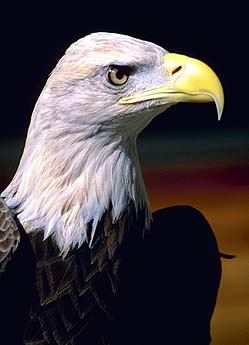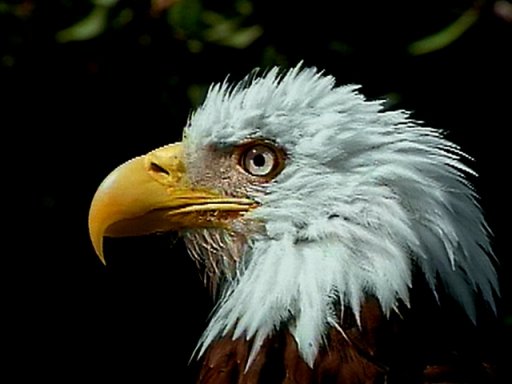Bald Eagle
Birds of Prey
Bald Eagles are birds of prey or raptors. They belong to the group Haliaeetus leucocephalus. Like all birds they are vertebrates with feathers. They lay eggs which have hard shells. Their skeletons are also extremely light weight partially because they have air sacs distributed throughout their bones. In addition, like other birds, bald eagles have a large sternum which supports the large flying muscles of the chest and wings.
The average life span of this hunter is 15-20 years. Although some eagles have been known to live for thirty years. During this time an eagle or eagle pair hunts within a specific area. This area can be seasonal for the birds which live farther north and migrate seasonally. The range of a bald eagle varies from 1,200 to 10,000 acres.
Bald Eagles live in North America from Alaska to Florida. It inhabits coastal areas or regions near lakes, streams, and rivers.
The Body of the Bald Eagle
The bald eagle is the second largest bird of prey in North America. It is second only to the California Condor. Bald Eagles weigh 10 to 12 pounds with the female being slightly larger than the male. It has a wing span of 6' to 7'6" (1.8-2.3 m). With this large wingspan the eagle is able to fly at 20-40 mph (32-64 km/h) and dive at speeds of up to 100 mph (160 km/h).
Bald eagles mature sexually at the age of 4 years and can breed annually thereafter. These birds mate for life, although the death of a mate may cause the other to select a new partner. While able to breed each year, sometimes pairs choose not to breed which may be a reflection of an inadequate food supply or other causes.
Bald eagles are marked with a white head and tail feathers. While their name would seem to come from the fact that from a distance these birds have feather-less heads, the name "bald" actually originates from the word "piebald." This word is largely obsolete now but its definition is "marked with white."
These white markings are the distinction of the mature eagle taking 4-5 years to develop. The young eaglet also differs from the adult in the color of its beak. The younger bird has a dark beak, but the adult eagle's beak is a bright yellow.
Nesting
Each breeding season the female can lay 1-3 eggs about the size of a goose egg. The eggs are laid approximately 2-3 days apart and incubate for about 35 days. These eggs are laid in a nest that is usually 5' in diameter. However, as the nests are reused over the years, a pair of eagles add to their nest which may grow to be 9 1/2' (3 m.) in diameter.
Bald eagles prefer to build their nests in large tall trees or on a cliff located near water. However, they have been known to build their nests on the ground when necessary.
Once the eggs are laid, the mother bird stays near the nest until the chicks hatch and while they are covered with down. The male is relied upon for all food during this time. Once the chicks begin to feather out, the female joins the male in hunting for food for the family.
Eagle Food
As raptors these large birds have grasping toes with curved sharp claws called talons. These creatures hunt only during the day searching mainly for fish. Because of its preference for fish the bald eagle is sometimes called the sea eagle.
Although the bald eagle hunts mainly fish it will also eat small mammals, water birds, and carrion. It tends to hunt fish near the surface of the water allowing only its feet to enter which means the fish it eats is generally spawn near the surface or are injured or already dead. Sometimes this bird will badger an osprey, another smaller raptor which preys upon fish, until this bird drops its catch which the bald eagle then steals.

Threatened
Several things have threatened the existence of the bald eagle. Destruction of its habitat has limited this great birds' hunting and breeding grounds. Destruction of forests for logging and the spread of human population has taken much ground.
The use of DDT and other insecticides have endangered the bald eagle. These pesticides run off into streams and lakes poisoning the fish and water fowl in the area. As the top link of this food chain the eagles ingest large amounts of these chemicals. It has been found that these insecticides, especially DDT can cause a fatal eggshell thinning during breeding. Chicks die before becoming viable.
In many areas this bird was also hunted, especially in northern areas such as Alaska. The Alaskan Bounty Law enacted in 1917 paid 50 cents a pair for the feet of a bald eagle. In just 5 years 16,000 birds were killed. In 1923 the price rose to $1 for a pair of feet and by 1940 another 80,000 bald eagles had been killed.
The bald eagle is a protected bird in all 50 states with Alaska having been the last hold out. It wasn't until 1953 that the bald eagle became a protected species in Alaska and could therefore no longer be hunted. Then in 1973 the bald eagle was protected again under the Endangered Species Act.
These laws have allowed the bald eagle to make a comeback. On July 4, 2000 the bald eagle was removed from the endangered species list. While it has not reached its original numbers it can now be seen roosting in flocks and breeding in a variety of habitats.
Our National Bird
Designated as the National Bird of the United States in 1782 the bald eagle appears on postage stamps, quarters, and dollar bills.
The bald eagle is featured on the Great Seal of the United States as designed by Charles Thompson and adopted on June 20, 1782. The reverse side of the official seal is the design used on the one-dollar bill, where the eagle faces to the left, toward the wheat spray and away from the arrows in its other claw. The bald eagle also appears on the United States Presidential Seal.

Bald Eagle Facts
- Bald eagles can see a fish from 2 miles away.
- An eaglet grows quickly, adding about 1 pound of body weight every 4-5 days.
- Approximately 1 out of 18 hunting attacks by this eagle are successful.
- The bald eagle sometimes plunges into the water to catch a fish using its wings to swim rather than fly.
- Occasionally the first eaglet born will kill its ensuing siblings without interference from the parents.
- A bald eagle has approximately 7,000 feathers.
- It was believed as late as the 1930's that bald eagles preyed upon pigs, sheep, and cattle. One story even accused the bald eagle of taking off with an 8 year old boy.
- About 50,000 bald eagles live in the United States today.
- Approximately 40% of young eaglets do not survive their first flight.
- Almost 80% of the bald eagle population resides in Alaska today.
- Bald eagles will walk about their nest with their talons, which grow continually, held in a closed ball to keep from accidentally injuring their offspring.
Books for Children
- The Bald Eagle - Endangered No More by Mac Priebe - Historical and biological information combined with photographs, illustrations, and maps make this a wonderful book for any interested person. Appropriate for children ages 7 and older. (amazon.com has it)
- Soaring With the Wind: The Bald Eagle by Gail Gibbons - Simple yet informative text accompanied by beautiful watercolor illustrations makes this a book appropriate for the very youngest bird fans. Interesting for ages 3 - 10. (amazon.com has it)
- On the Day the Tall Ships Sailed by Betty Parakevas - This book has lovely paintings to accompany the poetic text. The words are actually lyrics to a patriotic song by the author and the music is included in the back. Appropriate for children 3-9. (amazon.com has it)
- Bald Eagles: Their Life and Behavior in North America by Art Wolfe - Stunning photographs and informative text show many aspects of this birds growth and behavior. From nesting and mating to hunting and resting these birds are depicted beautifully. While the text is definitely for those 10 and older, all ages can enjoy the full color photographs. (amazon.com has it)
- National Audubon Society Field Guide to North American Birds: Eastern Region - A very nice field guide for anybody interested in going birding. Appropriate for children ages 9 and older. (amazon.com has it) A western region book is also available.
- Birds (Usborne First Nature) by Rosamund Kidman Cox and Barbara Cox - A book for the young scientist describes what a bird is and highlights features from various types of birds. Appropriate for children 6-9. This book is currently not being published so check your local library for a copy.
Links
- Welcome to www.midwest Eagles.com by Gary - this site has a great photo gallery and each picture is accompanied by an interesting fact about this marvelous bird.
- Great Outdoor Recreation Pages (GORP) by Diane and Bill Greer - this site explains some of the hazards eagles once did and still do face. It describes a variety of places across North America where bald eagles can now be observed with relative ease.
- American Bald Eagle Information by baldeagleinfo.com - contains facts, information, poems, photographs and more about our national bird.

